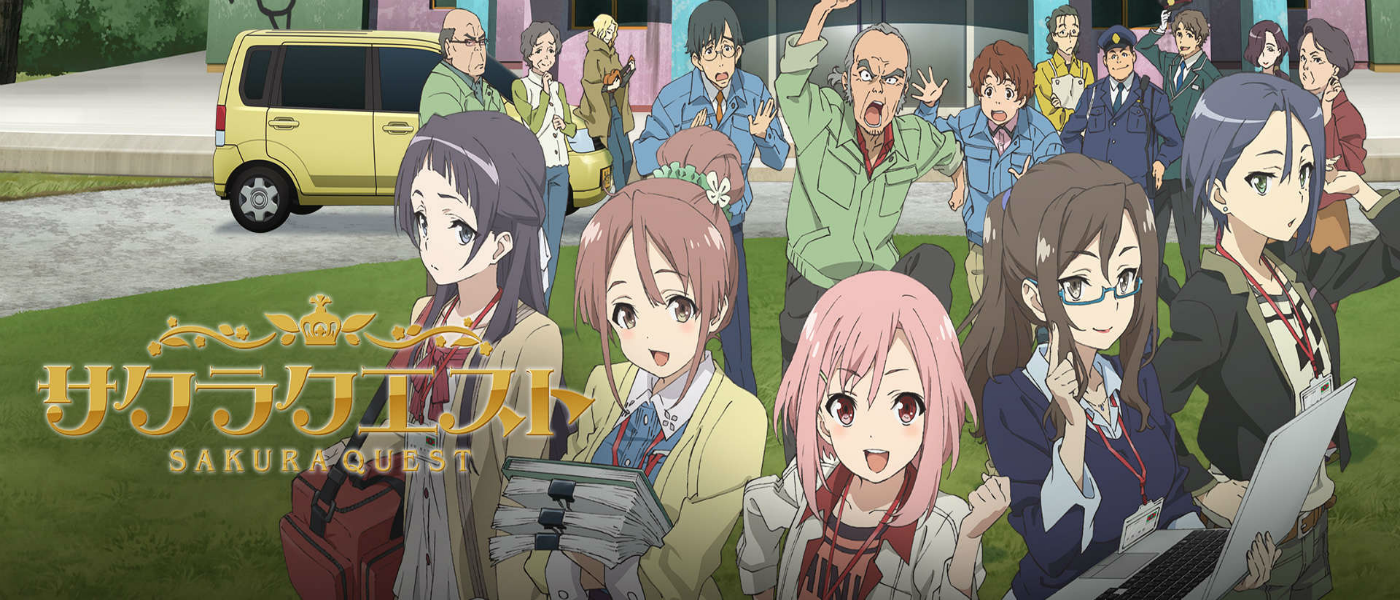English Dub Review: Sakura Quest “The Foggy Folklore”
When ability grooves with opportunity, there you will find destiny.
Overview (Spoilers)
The team tracks down the second festival treasure, the Hanging Drum. It’s in a terrible state of disrepair, and will take several thousand yen to put on a new head, but finding it is a step in the right direction. With only one treasure left, Yoshino takes Kadota on a trip to trace the festival parade route, hoping to discover the meaning and symbolism behind the original festival. Unfortunately, even in Kadota’s youth, it was just something they repeated, and its meaning was even lost to them. In the meantime, Maki’s issues with her father continue, nearly ruining her mother’s birthday dinner with an argument. Really, as hard as he is on her, he’s more disappointed that she isn’t following her dream. She’s received an invitation to audition for a movie but turned it down. After hearing this, Yoshino and Sanae practically shove her into the train. Yoshino inspires her: no matter how hard things may be, Maki knows what she is made for, and should pursue it.

I like how the festival treasure storyline draws the main characters into new issues around town that they can deal with. Here, the Drum brings them to an abandoned middle school. The building is scheduled to be bulldozed, but after seeing it, they wonder if ti might be of some use to the town, such as housing tourists or acting as a specialist academy. A large building like that could even be used as a business center or convention hall, but the big problem is the renovation. Solving that would turn it into a source of jobs for the entire town, and a draw for business and tourism alike. Using the treasures like this takes the girls out of their typical haunts, and gives the story more of a quest feel. Even though they never technically leave the Kingdom of Chupakabura, they still go on a journey. With this “Hero’s Journey” format, the story allows the characters to grow and develop in ways that a typical slice-of-life couldn’t.
Ironically, the archetype that this episode presents as a challenge is “The Atonement of the Father”, both literally and figuratively. The overarching story of the quest is to rekindle the festival. This is, in a way, them stepping up to confront the power that came before. The old ceremony, and its absence has the village stuck in a rut. They are connected, but they aren’t unified. The team is attempting to face this head on recreating the festival, but giving it new meaning. If they succeed, they will take the power of solidarity from the old festival, and wield it for themselves to bring the town back to life. This is also Maki’s struggle. She assumes that her father’s disapproval of her stems from the fact that she quit college. In actuality, his real disappointment was in her not following her dreams. He can see that she isn’t happy, and it rubs him the wrong way that she isn’t acting. Given how this show runs, I’m going to guess that Maki isn’t going to get the role, but pursuing it is key to her “Atonement of the Father” path. When she completes it, she will have acquired what her father shows he already has, fulfillment in his vocation. I enjoyed seeing Ririko inadvertently nudge Maki down her path by asking for help with singing on camera. Perhaps Maki’s calling is in teaching others to act?
Also, I just noticed that there is a bit of an allusion to Japanese myth in the festival treasures the girls are seeking. The three sacred treasures of Japan are the sword (Kusanagi-no-Tsurugi), the mirror (Yata-no-Kagami), and the jewel (Yasakani-no-Megatama). Each of these are traced back to Amaterasu, kami of the sun and progenitor of the imperial family, and Susano0, her brother. They have been passed down through the generations, and possession of them is the very definition of a true dynasty in Japan. The Mizuchi Festival treasures are very similar to these Sacred Treasures but are made to conform to the early myth of the dragon in the cave. The staff is an analogue to the sword, as it is a symbol of power. However, it isn’t military power in this sense, but the power to unite the people. The staff holds the flag that tells everyone why they are gathering and was likely made to announce the festival that was to welcome the dragon. The drum is actually quite close to the mirror, and not only in round shape. The drum was used to play the music intended to draw the dragon out, just as the mirror in Japanese myth was used to draw Amaterasu out of her cave with her own beauty. The golden dragon statue is a direct connection to the dragon, being an effigy of it. This serves the same purpose as the megatama, which were jewels that were held to be a direct connection with the divine or at least the mystical.
The girls are trying to discover the meaning behind the festival, but the treasures themselves (along with the myth of the dragon and the dragon song) are the key. In the story, the dragon came to the already-existing village, and intended to live there, but was frightened into a cave, where it died. Bodies of water, such as ponds, lakes, and streams, are often held in Japanese myth to be guarded and represented by a dragon. The Sakura Pond is an artificial body of water, and as such, the dragon “came to the village”. The festival float would pass through the town, then cross the pond to get to the dragon’s shrine. This recreates the gathering of the townsfolk to welcome the dragon, but when they found the dragon ran into a cave, they chased it and continued outside. When they realized the dragon died, they wrote the dragon song to sooth it. This festival is a symbolic recreation of the town’s most key myth, and a calling of the townsfolk to not only stand together but to forgive each other’s slights and consider each other’s points of view. If successfully recreated and understood, the festival could not only revive the town but heal the relationships therein. This episode may not have been much in and of itself, but when taken into its proper context, it has real depth to its storytelling. I enjoyed it
Our Take
Visually, this episode was as beautiful as ever and attentive to the details. Even tiny details like how the girls’ hair moved as they walked. It was smoothly done enough and followed the rhythm of their walk. Normally, this wouldn’t be worthy of note, but it’s just an example of how P.A. Works deals with its animation. Unfortunately, they’ve painted themselves in a bind. Between this attention to the details and some of the amazing shots we’ve seen in the past, their work in more modern episodes doesn’t have much impact or wow-factor. I know they have it in them, and they’re simply holding onto it for more poignant scenes. But now I’ve come to expect it of them, and I haven’t seen it in full force in a while. Compared to other studios, they’re way ahead of the game, but it feels as if they might be getting into a rut.
Voice acting? Oh, let me tell you. Not only did we get brilliant performances from Leah Clark (Maki) and Christopher Sabat (Maki’s father), but we got to hear a bit more of Brina Palencia’s singing voice. I really enjoyed it. The episode featured Ririko finding confidence in her voice. Brina managed to portray this well. The first time Ririko sang in the episode, it was shaky and small. When she sang in front of Maki, it was much stronger and dang beautiful. So, hats off, Brina. Great job.
So, this episode has great voice acting and deep storytelling, but not much actually happens and the animation lacks punch. I still love this show and want to see how each character’s individual story fits into the whole of the plot. There’s been a lot of setups prior to the Mizuchi Festival story arc, and I doubt the writers that are capable of this level of subtle, deep story would let that all go to waste. I give this episode eight busted drums out of ten.



























Hi Ashley, thank you so much for reading and we love the feedback. Note that on that day we had 14th posts go up and only ten posts show on the front page, so it's possible the preview had already been archived by the time you got to it. One recommendation would be to add our RSS feed to your favorite news aggregator service like Feedly, this way you get all of the latest posts!